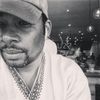The Spiritual Renaissance of African Classicist Jules Arthur... a la Cuba

“Yes, there is communication and dialog between our ancestors and my work. I am naturally drawn to the many aspects of ancestral lineage. Their plot, struggles and triumphs give rich meaning to the human condition. It is the exploration of these attributes that give my interests and work great cause.”
Jules Arthur’s work is artful at an atomic level, meaning it is nuclear - looks classic and understated but is prolific in the culture at large and in the private collections of our culture’s thought leaders, indisputable movers and shakers. It is seemingly demure in presentation but explosive in it’s impact. It is on this earth but cosmic in it’s vision and reach. His work is displayed in the collections of Kevin Spacey, Senator Corey Booker, Jay-Z, Van Jones, Marc Lamont Hill, Henry Louis Gates, Kate Hudson and Pras Michel of the Fugees. You realize upon review of Jules Arthur that it is everywhere.
You realize upon further contemplation of his process, that it always has been and always will be. It is ubiquitous. His work has been the subject of over a dozen exhibitions since 2001. His work is on movie posters, US senator’s offices and is displayed at the Schomburg Cultural Center For Research in Black Culture and Hutchin’s Center for African & African American Research at Harvard University. As described, Jules Arthur’s work is chévere - slang in Cuba, Puerto Rico, Dominican Republic, Venezuela and Colombia for cool, awesome or terrific. His commitment to the African aesthetic towering - he is a vessel through which ancestral energies are expressed and manifested.
“Arthur's process combines painting and sculpture comprised of hand-crafted elements that he designs and creates using traditional methods. He transforms raw materials – constructing, layering, distressing – thereby transporting us back to another era, connecting us to his subjects and their stories.”
For years now, through a process well documented, Jules has worked with paint, thread, cowrie shells, wooden frames, glue, artifacts, intellect, stencils, gold paint, spiritual alchemy and artifacts to re-create the energy of past worlds in the present. You see the eternal rhythms of poetry and the West African djembe - rope-tuned skin-covered goblet drum - in his work. It is the eternal African rhythm in color, on a canvass. The intentions of his spirit are clear with subject matter, and their effect upon patrons - African accomplishment is magnificent and to be revered. That work must not only be preserved but tower in the present day and in future worlds to come.
While formally trained with a B.F.A. from NYC’s The School of Visual Arts (graduating with honors), he is trained by the masters. He was mentored by our Harlem Renaissance’s Robert Blackburn (MacArthur Fellow) while attending the Robert Blackburn Printmaking Workshop. So, he is committed to the aesthetic of excellence that is organic to our culture too.
“Cuba is the definition of a magical place in the world to me. It is magical in the sense that it is a historical epicenter that gave birth and rise to so many new special and powerful ways of living that have lasted through the centuries and into our current day.”
So, when President Obama announced a reversal of decades old policy, opening American borders to Cuba, it was inevitable that Jules Arthur would make his way back. That’s how black works. It is magic contoured with with the real. It is the incomprehensible walking real time. It is is the impossible realized. In particular, Afro-Cuban culture has been a subject of Jules Arthur’s work with pieces as Havana’s Finest or Azucar De La Havana (both images are below).
This interview deals with not only Jules Arthur’s trip to Cuba, but also the spirit of the fighter in his work, Muhammad Ali, the righteous spirit of the fighter in President Barack H. Obama, the African Renaissance that was 2016 and the process by which his work comes to life.
“Cuba excites every nerve I possess about diving deep into rich roots and culture... And there is no richer place than Cuba with its beautiful turbulent past that reaches back as far as the days when The Taino and Awrawkan people ruled the Greater Antilles.”
1.) What was the purpose of your recent trip to Cuba – what were you looking for?
My general consensus is that the majority of people in life dream of setting out into the world and visit their favorite destinations around the world. Traveling in itself is such a crucial educational wonderment that all should be blessed with.
“My artist spirit vigorously keeps my creative mind contemplating the wonders of past history.”
As Cuba was my number one destination, I just went on the journey of my dreams. Cuba represents my thirst for historical crossroads that had huge impacts on world history when people set out for new lands. To answer the question “what was I looking for?” Cuba excites every nerve I possess about diving deep into rich roots and culture. There is a notion that states artists have a duty to speak about his or her times. A duty that states a need to creatively address the issues that grips the era in which they live in. There is a part of me that fully understands the merits in that thinking.
But I feel there is a greater duty to honor what naturally evolves in the artist’s spirit. Not to steer it so much but to let the creative spirit gracefully guide the artist to unpredictable creative depths. My artist spirit vigorously keeps my creative mind contemplating the wonders of past history.
“There is an African tradition that practices the act of intentionally breaking things apart to only reform them in arrangements that provoke greater thought and impact than its original form.”
You’ll find the body of my work exploring the vast riches that have historically evolved and taken place through out the world. I prefer to juxtapose history’s unique moments and convey them in a sense that challenges the status quo or give reason to ask more questions. My work simultaneously gives honor and respect to unsung and celebrated individuals who have made an important mark. And there is no richer place than Cuba with its beautiful turbulent past that reaches back as far as the days when The Taino and Awrawkan people ruled the Greater Antilles. As Spanish Conquistadors set out for riches in these lands, I went to Cuba in search of riches in the form of historical crossroads where Native peoples, Africans and Spanish cultures collided in unprecedented events.
“Through this baptism of fire the African spirit gave rise to new powerful forms in these new land. These cultures and practices prevailed and influence today’s societies across the world.”
2.) Is Cuba magic?
Cuba is the definition of a magical place in the world to me.
It is magical in the sense that it is a historical epicenter that gave birth and rise to so many new special and powerful ways of living that have lasted through the centuries and into our current day. There is an African tradition that practices the act of intentionally breaking things apart to only reform them in arrangements that provoke greater thought and impact than its original form. Objects and materials like plates, glass, dolls, fabric, dishes, metals, wood etc. are broken apart for artistic, spiritual and utilitarian reasons. They are reconfigured to come back in greater strength and to have a more powerful purpose as a new object, tool or expression. Through the African Holocaust (The African Slave trade), Cuba is comprised of so many shattered rich West African cultures that gave birth to new forms only imaginable in Cuba.
“New Orleans is for all intents and purposes, the birthplace of Jazz that echoed out across the world. But it was Cuba New Orleans’s big sister that gave Jazz its heartbeat in African rhythm and syncopation.”
Through the testament and iron clad will to live, African people and African traditions shape shifted and survived the brutal atrocities of being stripped of identity and dignity. Through this baptism of fire the African spirit gave rise to new powerful forms in these new land. These cultures and practices prevailed and influence today’s societies across the world. Cuba and neighboring islands that experienced the same baptism gave birth to an explosion of new and powerful artistry, food, fashion, musicality and spirituality.
When you think of Jazz, Hip Hop, fashion and certain forms of food you must consider its origins that were forged in the bloody fires of the African Antilles. New Orleans is for all intents and purposes, the birthplace of Jazz that echoed out across the world. But it was Cuba New Orleans’s big sister that gave Jazz its heartbeat in African rhythm and syncopation. It was Cuba’s legendary merchant ports that supplied the Antilles (Caribbean Nations) and American shores with the latest in fashion trends, foods, spices, textiles, musical expressions and commodities. Cuba is the jewel and the largest of the Caribbean islands many have fought and died for to control this important gateway to the Americas. Spain would rise to the top as a European Empire from its riches derived from its immense cash lucrative plantation crops of sugar cane. Sugar was king and the world demanded it. Cuba was that titan of industry and an epicenter where it supplied a staggering 1/3 of the worlds demand for sugar.
“When I walked the streets of Havana or the colonial town of Trinidad de Cuba my observation of the cities is as if the places simply froze in time.”
My natural affinity to dive deep into this rich lineage fuels my creativity in such a profound way. Cuba becomes this magical place where these combinations of historical accolades, transgressions, baptisms and metamorphosis give my work and creative soul validity. When I walked the streets of Havana or the colonial town of Trinidad de Cuba my observation of the cities is as if the places simply froze in time. Because of the controversial embargo overt modern elements did not get a chance to come in and gobble up the gorgeous architectural structures that you see through out the cities today. For an artist like me who finds a number of things distasteful in modernity Cuba offers a treasure trove of absolutely stunning layers that peel back and expose surfaces of endless color, texture and design. Havana is a city or permit me to say a palette that inspires every artistic sensibility in me. I look forward to my next journey back to this magical realm. May it always be available and may my return be sooner than later.
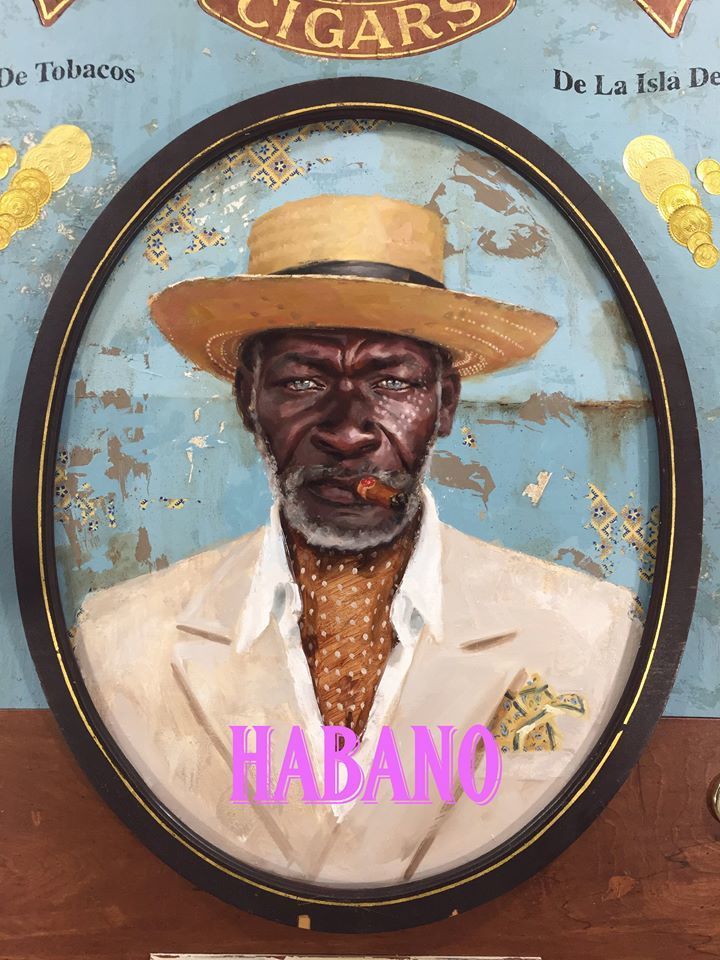
Jules Arthur, Havana’s Finest | oil on wood panel, constructed wooden box frame, fabric, leather, 23k gold leaf lettering, brass hardware, cigars from Cuba, mixed media | 41 x 60 x 4 inches | 2016
3.) From what you understand, how is the culture in Cuba transforming with the Obama/Castro doctrine in effect?
My descriptions speak from a purely artistic view. It is very easy to romanticize Cuba’s gorgeous backdrop and it’s more than hospitable demeanor. Crime in Cuba is 1/10 the issue it is in the US. They have no guns proliferating through out the streets. They do no tolerate illiteracy so everyone and I mean everyone receives the best education Cuba provides. I witnessed them having the same amount of freedom of speech as we do. Everyone receives healthcare and no matter your race, creed, gender or religion you are cared for without putting yourself in hock. It is far from a utopia and I would never describe it as that. But it becomes easy to fall in love with many aspects of Cuba.
“(M)y biggest take away is that they are proud and have an immense love for their country. They want to cultivate and preserve Cuban identity.”
I bring these things up first because visiting the city and being with its beautiful people you can easy forget that Cuba is an “enemy” of my homeland the US. The history between Cuba and the US is so rife with turbulence from the positions of the higher ups and leaders it make my standing on Cuban soil surreal when I really think about it. “I am standing on enemy territory. What does that mean?” I am very familiar with the details of history and what happened during the Cuban Revolution and the atrocities that occurred so I don’t dare belittle the experiences of those who lived through it.
In traveling to Cuba, I knew I wanted to have purpose driven conversations with Cubans about the embargo and social and political issues between our two nations. I wanted to focus on the perspective of the people from the heartland and not rely so heavily on the two government’s ideology. In having incredibly in depth conversations with a number of Cubans about Cuba’s history and social political atmosphere there and with the US, I walk away with respect for an extremely complex web of thoughts that differ from young and old.
I heard varying stances that emotionally speak about Cuba’s position and tumultuous history. Without regurgitating documented history, my biggest take away is that they are proud and have an immense love for their country. They want to cultivate and preserve Cuban identity.
You need not ask them if the embargo should be lifted. You will hear a resounding, “It should have been done years ago”. But they will not trade lifting the embargo at the expense of losing their identity and control. Currently, it’s the Cuban people not governments that are suffering from this tightening noose and lack of ability to share the world as others do. They are not looking for a handout and wouldn’t except it if you gave it to them. What the people are enthusiastically looking forward to is an equal partnership with the US on trade and goods. But they won’t tolerate America stepping in and controlling their markets or dictating policy over their proprietorship. They saw America’s presence in Cuba around the turn of the century until 1959 as a period of industrial boom but also a period of great despair. Similar to the Spanish plantations owner’s system of reaping all the benefits of the sugar industry only to send all the cultivated wealth back to Spain.
“They are proud to call themselves socialist but look for a new system that represents a hybrid of fairness and equality. They want a strong Cuban identity and the right to form equal partnerships with the world without someone sneaking in the back door and looting them.”
When America occupied the island, they took over Cuban industry in such a grotesque way it warped the balance of the island. The typical greed of living off the wealth of its resources, taking the money back to The US and barely leaving anything for Cubans kicked into high gear. Cuba became a glutinous destination for Americans so they totally rebuke capitalism. The consensus about getting in bed with Communist Russia was a major mistake. And excepting Russia’s weaponry was the ultimate mistake. So they rebuke communism. They are proud to call themselves socialist but look for a new system that represents a hybrid of fairness and equality. They want a strong Cuban identity and the right to form equal partnerships with the world without someone sneaking in the back door and looting them.
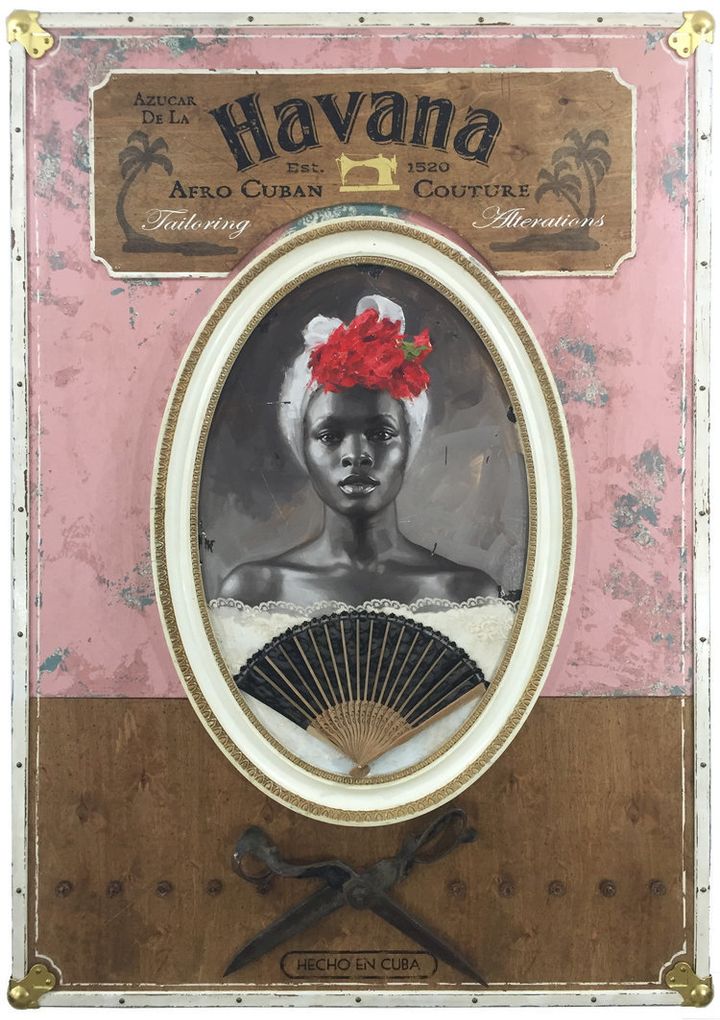
Azucar De La Havana/ oil on wood panel, gold leaf lettering, brass hardware, vintage shears, mixed media/ 39 x 56 x 4 inches/ 2016/ Visit Artsy Page for Chevere
When asked where are we from, we were met with joy. “AMERICA YES! It is a pleasure and honored to have you here. Please enjoy my country”. I can’t tell you how many times I heard this. Across the board they like Obama. He was not perfect but they are warm towards him. Cubans are looking forward to the changes that Obama was ushering in. Trump has mentioned he will roll back the momentum Obama has gained in relationships with Cuba. So they are puzzled, sad and worried to an extent about lost opportunities. After experiencing this beautiful country I mirror these exact feelings.
Part 1 of 3 pieces focusing on Jules Arthur’s work - You will find out more about his work at www.julesarthur.com. Below enjoy his photography from Cuba this past holiday. Jules Arthur’s work can be purchased at www.saatchiart.com
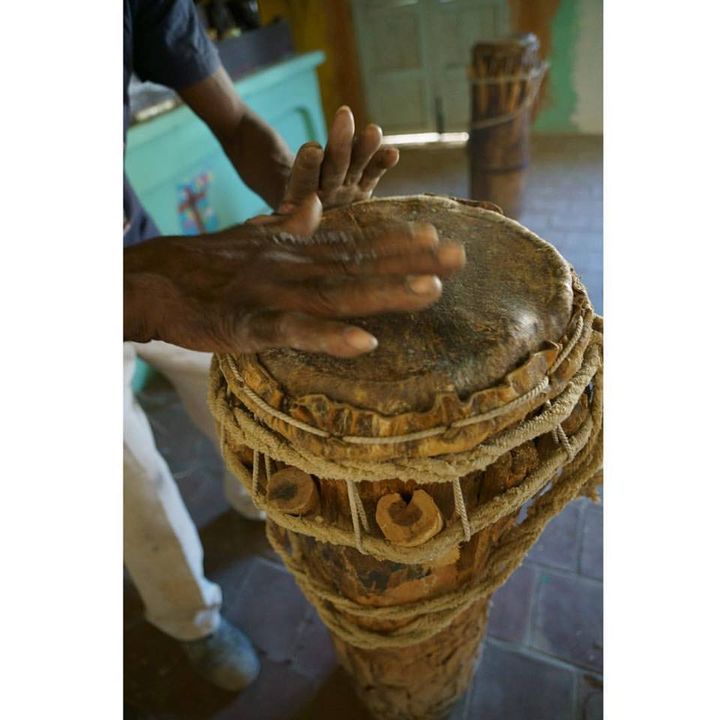
Afro-Cuban Religion: Santeria Temple. Cabildo de los Congos Reales de San Antonio, Trinidad, Cuba Here we heard a part of Oru-de-Igbodu-para-Yemaya-Eleggua
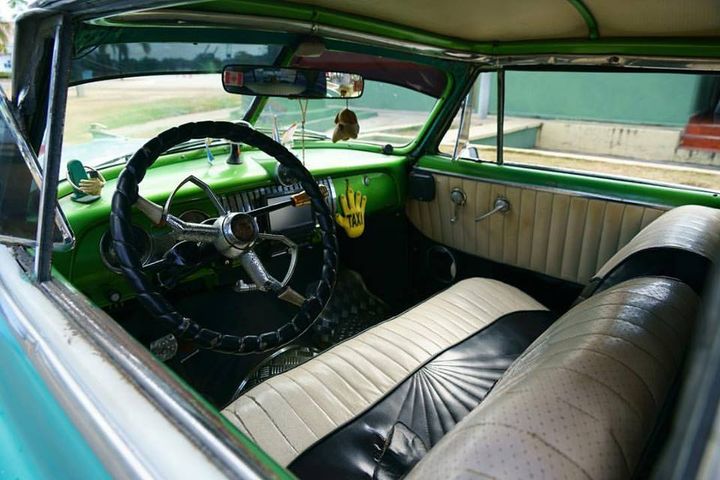
“As if time stopped in the 1950's Cuba is filled with thousands of these surreal 50's gems from America. These chariots which come in every color imaginable dot the landscape giving Cuba another layer of magic. 🇨🇺And the shell stitched leather seats...1950's Chevy Bel Air Coupe.”
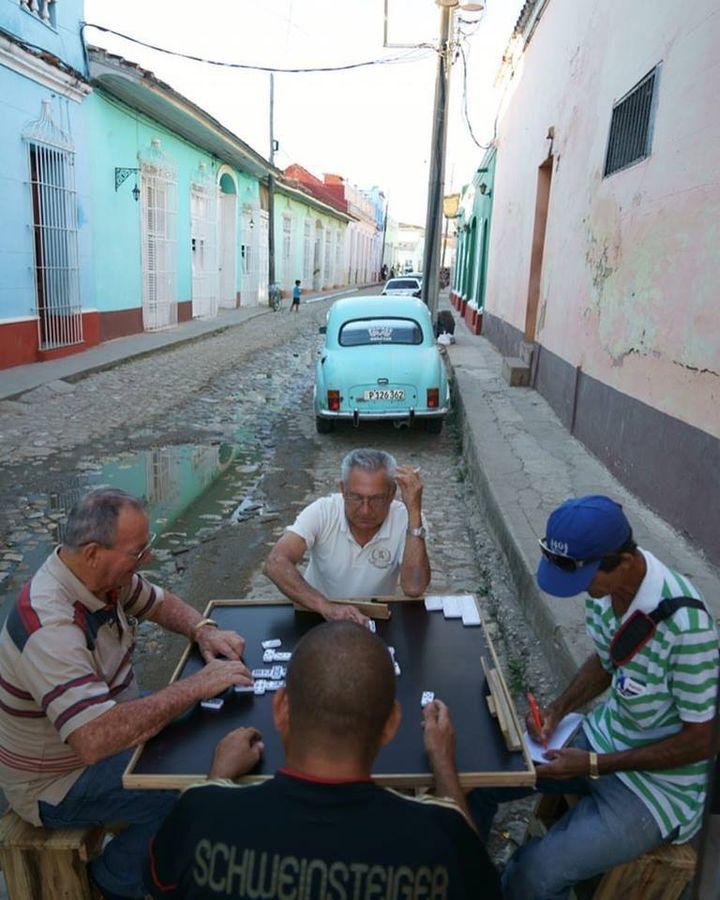
¡Feliz año neuvo de Cuba! 🇨🇺💫🎉. Happy New Year from Cuba!!! Let the world get on the path of coming together as one in 2017 and beyond. Cheers!!!
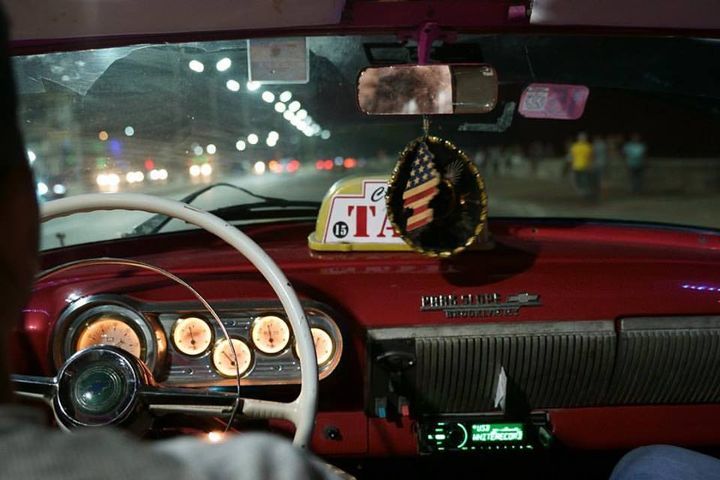
“Meyer Lansky said the best way to experience Havana is in the back seat of a convertible driving down El Malecón. These Havana nights are so special.”
